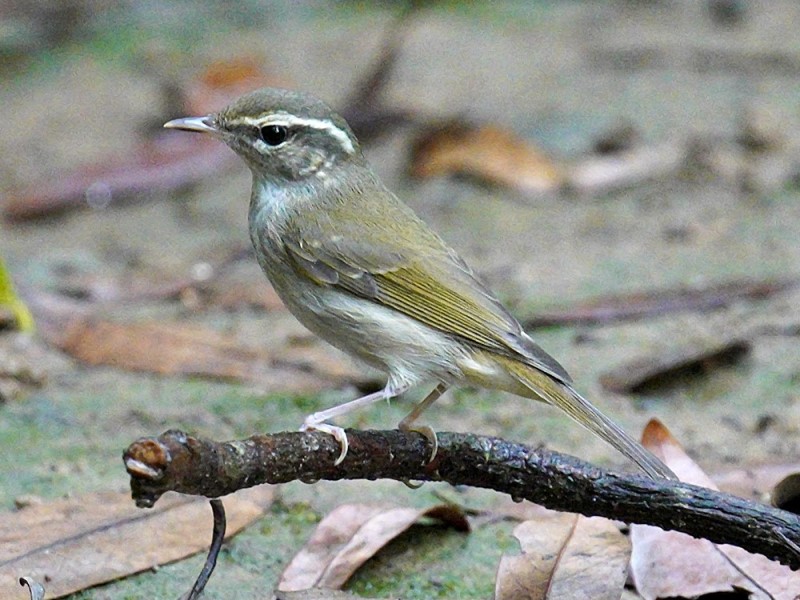Pale-legged Leaf Warbler Phylloscopus tenellipes 淡腳柳鶯
Category I. Common passage migrant in autumn, scarce winter visitor and spring migrant; occurs mainly in closed-canopy woodland and shrubland.
IDENTIFICATION

Sep. 2019, Roman Lo.
10-11 cm. Relatively short-billed and brownish-tinged leaf warbler with darker and greyer crown and eye-stripe, poorly-marked pale wing bars and pale pinkish legs. Often has an obvious pale tip to the bill. The supercilium is broader than that of Arctic Warbler, often broadest above the eye and kinks upward at the rear when the body and head are aligned horizontally. The ear coverts are pale meaning the eye-stripe is prominent. The underparts are whiter than those of Arctic Warbler and the undertail coverts can rarely be very faint yellow (Leader 1993). Apparently indistinguishable from Sakhalin Leaf Warbler on plumage but may have a slightly shorter primary projection. Habitual tail-dipping also distinguishes it from other Phylloscopus warblers in HK.
VOCALISATIONS
The vocalisations of this species are critical in field identification. The usual call is a single moderately high-pitched, sharp ‘tee, ‘tsee’ or ‘tip’ at a frequency of 5.5-5.9 kHz (Hungnon et al. 2017, pers. obs.), which is comparable to the middle part of the frequency range of the typical call of Yellow-browed Warbler. With experience, the call of many birds is distinguishable from the call of Sakhalin Leaf Warbler, which is 0.25 kHz to 1.4 kHz lower in pitch.
The song is a rapid trill at approximately the same pitch or slightly higher than the call. Most similar to the song of Rufous-faced Warbler, it is however thinner, slightly higher in pitch and each phrase is slightly longer.
DISTRIBUTION & HABITAT PREFERENCE
Pale-legged Leaf Warbler occurs in widespread areas where suitable wooded cover for migrants exists, but particularly in woodland and closed-canopy shrubland. There appears to be no difference from Sakhalin Leaf Warbler in habitat preference.
OCCURRENCE
Common passage migrant in autumn but scarce in winter and spring. The earliest autumn date is 27 August 1997 and 2016 (a previous earliest of 20 August 2019 has been withdrawn by the observer), with main autumn passage occurring from the third week of September to the first week of October. Numbers fall through October into the first half of November, by when the wintering population appears established. After the turn of the year it is much scarcer, and the winter population has probably departed by early to mid-March. There is a small passage in April that peters out at the end of the month, and there are only a few records in early May, the latest on the 6th.
BEHAVIOUR, FORAGING & DIET
Generally forages in shrub or shrub understorey in the lower layer of the forest, but also occurs in densely vegetated parts of some urban parks. Singing birds, which are mainly reported in April, particularly the second half, ascend higher in trees.
RANGE & SYSTEMATICS
Monotypic. Breeds in Ussuriland, northeast China and North Korea. The non-breeding season distribution is now understood to be the south China coast and Hainan south through much of mainland southeast Asia to Singapore (Clement 2020) and therefore probably also north Sumatra.
CONSERVATION STATUS
IUCN: Least Concern. Population trend stable.
Figure 1.

Clement, P. (2020). Pale-legged Leaf Warbler (Phylloscopus tenellipes), version 1.0. In Birds of the World (J. del Hoyo, A. Elliott, J. Sargatal, D. A. Christie, and E. de Juana, Editors). Cornell Lab of Ornithology, Ithaca, NY, USA. https://doi.org/10.2173/bow.pllwar1.01
Hungnon, C., J. Khudamrongsawat, S. Manawattana, A. J. Pierce and P. D. Round (2017). Distinguishing between Sakhalin Leaf Warbler Phylloscopus borealoides and Pale-legged Leaf Warbler P. tenellipes on call. Forktail 33 (2017): 77-80.
Leader, P. J. (1993). The field identification of Arctic, Eastern Crowned, Two-barred Greenish and Pale-legged Leaf Warbler in Hong Kong. Hong Kong Bird Report 1992: 153-159.

